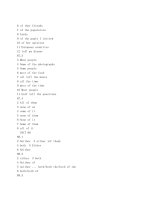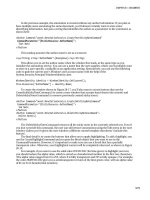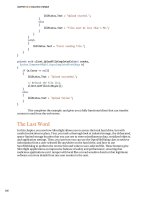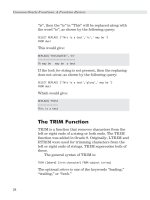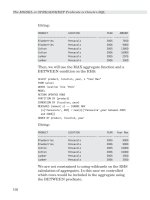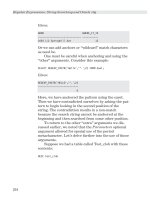advanced sql Functions in Oracle 10G phần 10 pptx
Bạn đang xem bản rút gọn của tài liệu. Xem và tải ngay bản đầy đủ của tài liệu tại đây (1.53 MB, 39 trang )
LOWER
This function converts every letter of a string to lower
-
case. The general format for this function is:
LOWER(string)
For example, the query:
SELECT LOWER('PUTS IN LOWERCASE') FROM dual
Will give:
LOWER('PUTSINLOWER
puts in lowercase
LPAD
This function makes a string a certain length by adding
(padding) a specified set of characters to the left of the
original string. LPAD stands for “left pad.” The gen-
eral format for this function is:
LPAD(string, length_to_make_string,
what_to_add_to_left_of_string)
For example, the query:
SELECT LPAD('Column', 15, '.') FROM dual
Will give:
LPAD('COLUMN',1
Column
360
String Functions
LTRIM
This function removes a set of characters from the left
of a string. LTRIM stands for “left trim.” The general
format for this function is:
LTRIM(string, characters_to_remove)
For example, the query:
SELECT LTRIM(' Mitho', '.') FROM dual
Will give:
LTRIM
Mitho
REGEXP_INSTR
This function returns the location (beginning) of a pat-
tern in a given string. REGEXP_INSTR extends the
regular INSTR string function by allowing searches of
regular expressions. The simplest form of this function
is:
REGEXP_INSTR(source_string, pattern_to_find)
This part works like the INSTR function.
The general format for the REGEXP_INSTR
function with all the options is:
REGEXP_INSTR(source_string, pattern_to_find [, position,
occurrence, return_option, match_parameter])
source_string is the string in which you wish to search
for the pattern.
361
Appendix
|
A
pattern_to_find is the pattern that you wish to search
for in a string.
position indicates where to start searching in
source_string.
occurrence indicates which occurrence of the pat
-
tern_to_find (in the source_string) you wish to
search for. For example, which occurrence of “si”
do you want to extract from the source string
“Mississippi”.
return_option canbe0or1.Ifreturn_option is 0, Ora
-
cle returns the first character of the occurrence
(this is the default); if return_option is 1, Oracle
returns the position of the character following the
occurrence.
match_parameter allows you to further customize your
search.
t
“i” in match_parameter can be used for case-
insensitive matching
t
“c” in match_parameter can be used for case-
sensitive matching
t
“n” in match_parameter allows the period to
match the new line character
t
“m” in match_parameter allows for more than
one line in source_string
For example, the query:
SELECT REGEXP_INSTR('Mississippi', 'si', 1,2,0,'i') FROM dual
Will give:
REGEXP_INSTR('MISSISSIPPI','SI',1,2,0,'I')
7
362
String Functions
REGEXP_REPLACE
This function returns the source_string with every
occurrence of the pattern_to_find replaced with the
replace_string. The simplest format for this function is:
REGEXP_REPLACE (source_string, pattern_to_find,
pattern_to_replace_by)
The general format for the REGEXP_REPLACE
function with all the options is:
REGEXP_REPLACE (source_string, pattern_to_find,
[pattern_to_replace_by, position, occurrence,
match_parameter])
For example, the query:
SELECT REGEXP_REPLACE('Mississippi', 'si', 'SI', 1, 0, 'i')
FROM dual
Will give:
REGEXP_REPL
MisSIsSIppi
REGEXP_SUBSTR
This function returns a string of data type VAR
-
CHAR2 or CLOB. REGEXP_SUBSTR uses regular
expressions to specify the beginning and ending points
of the returned string. The simplest format for this
function is:
REGEXP_SUBSTR(source_string, pattern_to_find)
363
Appendix
|
A
The general format for the REGEXP_SUBSTR func
-
tion with all the options is:
REGEXP_SUBSTR(source_string, pattern_to_find [, position,
occurrence, match_parameter])
For example, the query:
SELECT REGEXP_SUBSTR('Mississippi', 'si', 1, 2, 'i') FROM dual
Will give:
RE
si
REPLACE
This function returns a string in which every occur-
rence of the pattern_to_find has been replaced with
pattern_to_replace_by. The general format for this
function is:
REPLACE(source_string, pattern_to_find, pattern_to_replace_by)
For example, the query:
SELECT REPLACE('Mississippi', 'pi', 'PI') FROM dual
Will give:
REPLACE('MI
MississipPI
364
String Functions
RPAD
This function makes a string a certain length by adding
(padding) a specified set of characters to the right of
the original string. RPAD stands for “right pad.” The
general format for this function is:
RPAD(string, length_to_make_string,
what_to_add_to_right_of_string)
For example, the query:
SELECT RPAD('Letters', 20, '.') FROM dual
Will give:
RPAD('LETTERS',20,'.
Letters
RTRIM
This function removes a set of characters from the
right of a string. RTRIM stands for “right trim.” The
general format for this function is:
RTRIM(string, characters_to_remove)
For example, the query:
SELECT RTRIM('Computers', 's') FROM dual
Will give:
RTRIM('C
Computer
365
Appendix
|
A
SOUNDEX
This function converts a string to a code value. Words
with similar sounds will have a similar code value, so
you can use SOUNDEX to compare words that are
spelled slightly differently but sound basically the
same. The general format for this function is:
SOUNDEX(string)
For example, the query:
SELECT SOUNDEX('Time') FROM dual
Will give:
SOUN
T500
String||String
This function concatenates two strings. The general
format for this function is:
String||String
For example, the query:
SELECT 'This' || ' is '|| 'a' || ' concatenation' FROM dual
Will give:
'THIS'||'IS'||'A'||'CON
This is a concatenation
366
String Functions
SUBSTR
This function allows you to retrieve a portion of the
string. The general format for this function is:
SUBSTR(string, start_at_position, number_of_characters_
to_retrieve)
For example, the query:
SELECT SUBSTR('Mississippi', 5, 3) FROM dual
Will give:
SUB
iss
TRANSLATE
This function replaces a string character by character.
Where REPLACE looks for a whole string pattern and
replaces the whole string pattern with another string
pattern, TRANSLATE will only match characters (by
character) within the string pattern and replace the
string character by character. The general format for
this function is:
TRANSLATE(string, characters_to_find, characters_to_replace_by)
For example, the query:
SELECT TRANSLATE('Mississippi', 's','S') FROM dual
367
Appendix
|
A
Will give:
TRANSLATE('
MiSSiSSippi
TRIM
This function removes a set of characters from both
sides of a string. The general format for this function
is:
TRIM ([{leading_characters | trailing_characters | both}
[trim_character]) |
trim_character} FROM | source_string)
For example, the query:
SELECT TRIM(trailing 's' from 'Cars') FROM dual
Will give:
TRI
Car
UPPER
This function converts every letter in a string to upper
-
case. The general format for this function is:
UPPER(string)
For example, the query:
SELECT UPPER('makes the string into big letters') FROM dual
368
String Functions
Will give:
UPPER('MAKESTHESTRINGINTOBIGLETTE
MAKES THE STRING INTO BIG LETTERS
VSIZE
This function returns the storage size of a string in
Oracle. The general format for this function is:
VSIZE(string)
For example, the query:
SELECT VSIZE('Returns the storage size of a string') FROM dual
Will give:
VSIZE('RETURNSTHESTORAGESIZEOFASTRING')
36
369
Appendix
|
A
This page intentionally left blank.
Appendix B
Statistical
Functions
The following dataset (table), Stat_test, is used for all
the query examples in this appendix:
YX
21
72
93
12 4
15 5
17 6
19 7
20 8
21 9
21 10
23 11
24 12
371
Appendix
|
B
AVG
This function returns the average or mean of a group of
numbers. The general format for this function is:
AVG(expr)
For example, the query:
SELECT AVG(y) FROM stat_test
Will give:
AVG(Y)
15.8333333
CORR
This function calculates the correlation coefficient of a
set of paired observations. The CORR function returns
a number between –1 and 1. The general format for
this function is:
CORR(expr1, expr2)
For example, the query:
SELECT CORR(y, x) FROM stat_test
Will give:
CORR(Y,X)
.964703605
372
Statistical Functions
CORR_K
This function calculates a rank correlation. It is a non-
parametric procedure. The following options are avail
-
able for the CORR_K function.
For the coefficient:
CORR_K(expr1, expr2, 'COEFFICIENT')
For significance level of one-sided test:
CORR_K(expr1, expr2, 'ONE_SIDED_SIG')
For significance level of two-sided test:
CORR_K(expr1, expr2, 'TWO_SIDED_SIG')
CORR_S
This function also calculates a rank correlation. It is
also a non-parametric procedure. The following options
are available for the CORR_S function.
For the coefficient:
CORR_S(expr1, expr2, 'COEFFICIENT')
For significance level of one-sided test:
CORR_S(expr1, expr2, 'ONE_SIDED_SIG')
For significance level of two-sided test:
CORR_S(expr1, expr2, 'TWO_SIDED_SIG')
373
Appendix
|
B
COVAR_POP
This function returns a population covariance between
expr1 and expr2. The general format of the COVAR_
POP function is:
COVAR_POP(expr1, expr2)
For example, the query:
SELECT COVAR_POP(y, x) FROM stat_test
Will give:
COVAR_POP(Y,X)
22.1666667
COVAR_SAMP
This function returns a sample covariance between
expr1 and expr2, and the general format is:
COVAR_SAMP(expr1, expr2)
For example, the query:
SELECT COVAR_SAMP(y, x) FROM stat_test
Will give:
COVAR_SAMP(Y,X)
24.1818182
374
Statistical Functions
CUME_DIST
This function calculates the cumulative probability of a
value for a given set of observations. It ranges from 0
to 1. The general format for the CUME_DIST function
is:
CUME_DIST(expr [, expr] ) WITHIN GROUP
(ORDER BY
expr [DESC | ASC] [ NULLS {FIRST | LAST }]
[, expr [DESC | ASC] [NULLS {FIRST |LAST }]] )
MEDIAN
This function returns the median from a group of num-
bers. The general format for this function is:
MEDIAN(expr1)
For example, the query,
SELECT MEDIAN(y) from stat_test
Will give:
MEDIAN(Y)
18
375
Appendix
|
B
PERCENTILE_CONT
This function takes a probability value (between 0 and
1) and returns a percentile value (for a continuous dis
-
tribution). The general format for this function is:
PERCENTILE_CONT (expr) WITHIN GROUP (ORDER BY expr [DESC |
ASC]) OVER (query_partition_clause)]
PERCENTILE_DISC
This function takes a probability value (between 0 and
1) and returns an approximate percentile value (for a
discrete distribution). The general format for this func-
tion is:
PERCENTILE_DISC (expr) WITHIN GROUP (ORDER BY expr [DESC |
ASC]) OVER (query_partition_clause)]
REGR
This linear regression function gives a least square
regression line to a set of pairs of numbers. The follow
-
ing options are available for the REGR function.
For the estimated slope of the line:
REGR_SLOPE(expr1, expr2)
For example, the query:
SELECT REGR_SLOPE(y, x) FROM stat_test
376
Statistical Functions
Will give:
REGR_SLOPE(Y,X)
1.86013986
For the y-intercept of the line:
REGR_INTERCEPT(expr1, expr2)
For example, the query:
SELECT REGR_INTERCEPT(y, x) FROM stat_test
Will give:
REGR_INTERCEPT(Y,X)
3.74242424
For the number of observations:
REGR_COUNT(expr1, expr2)
For example, the query:
SELECT REGR_COUNT(y, x) FROM stat_test
Will give:
REGR_COUNT(Y,X)
12
For the coefficient of determination (R-square):
REGR_R2(expr1, expr2)
For example, the query:
SELECT REGR_R2(y, x) FROM REARP.stat_test
377
Appendix
|
B
Will give:
REGR_R2(Y,X)
.930653046
For average value of independent (x) variables:
REGR_AVGX(expr1, expr2)
For example, the query:
SELECT REGR_AVGX(y, x) FROM stat_test
Will give:
REGR_AVGX(Y,X)
6.5
For average value of dependent (y) variables:
REGR_AVGY(expr1, expr2)
For example, the query:
SELECT REGR_AVGY(y, x) FROM stat_test
Will give:
REGR_AVGY(Y,X)
15.8333333
For sum of squares x:
REGR_SXX(expr1, expr2)
For example, the query:
SELECT REGR_SXX(y, x) FROM stat_test
378
Statistical Functions
Will give:
REGR_SXX(Y,X)
143
For sum of squares y:
REGR_SYY(expr1, expr2)
For example, the query:
SELECT REGR_SYY(y, x) FROM stat_test
Will give:
REGR_SYY(Y,X)
531.666667
For sum of cross-product xy:
REGR_SXY(expr1, expr2)
For example, the query:
SELECT REGR_SXY(y, x) FROM stat_test
Will give:
REGR_SXY(Y,X)
266
379
Appendix
|
B
STATS_BINOMIAL_TEST
This function tests the binomial success probability of a
given value. The following options are available for the
STATS_BINOMIAL TEST function.
For one-sided probability or less:
STATS_BINOMIAL_TEST(expr1, expr2, p, 'ONE_SIDED_PROB_OR_LESS')
For one-sided probability or more:
STATS_BINOMIAL_TEST(expr1, expr2, p, 'ONE_SIDED_PROB_OR_MORE')
For two-sided probability:
STATS_BINOMIAL_TEST(expr1, expr2, p, 'TWO_SIDED_PROB')
For exact probability:
STATS_BINOMIAL_TEST(expr1, expr2, p, 'EXACT_PROB')
STATS_CROSSTAB
This function takes in two nominal values and returns a
value based on the third argument. The following
options are available for this function.
For chi-square value:
STATS_CROSSTAB(expr1, expr2, 'CHISQ_OBS')
For chi-square significance level:
STATS_CROSSTAB(expr1, expr2, 'CHISQ_SIG')
380
Statistical Functions
For chi-square degrees of freedom:
STATS_CROSSTAB(expr1, expr2, 'CHISQ_DF')
For other related test statistics:
STATS_CROSSTAB(expr1, expr2, 'PHI_COEFFICIENT')
STATS_CROSSTAB(expr1, expr2, 'CRAMERS_V')
STATS_CROSSTAB(expr1, expr2, 'CONT_COEFFICIENT')
STATS_CROSSTAB(expr1, expr2, 'COHENS_K')
STATS_F_TEST
This function tests the equality of two population vari-
ances. The resulting f value is the ratio of one sample
variance to the other sample variance. Values very dif-
ferent from 1 usually indicate significant differences
between the two variances. The following options are
available in the STATS_F_TEST function.
For the test statistic value:
STATS_F_TEST(expr1, expr2, 'STATISTIC')
For degrees of freedom:
STATS_F_TEST(expr1, expr2, 'DF_NUM')
STATS_F_TEST(expr1, expr2, 'DF_DEN')
For significance level of one-sided test:
STATS_F_TEST(expr1, expr2, 'ONE_SIDED_SIG')
For significance level of two-sided test:
STATS_F_TEST(expr1, expr2, 'TWO_SIDED_SIG')
381
Appendix
|
B
STATS_KS_TEST
This is a non-parametric test. This Kolmogorov-
Smirnov function compares two samples to test
whether the populations have the same distribution.
The following options are available in the
STATS_KS_TEST function.
For the test statistic:
STATS_KS_TEST(expr1, expr2, 'STATISTIC')
For the significance level:
STATS_KS_TEST(expr1, expr2, 'SIG')
STATS_MODE
This function returns the mode of a set of numbers.
STATS_MODE(expr)
For example, the query:
SELECT STATS_MODE(y) FROM stat_test
Will give:
STATS_MODE(Y)
21
382
Statistical Functions
STATS_MW_TEST
The Mann-Whitney test is a non-parametric test that
compares two independent samples to test whether two
populations are identical against the alternative
hypothesis that the two populations are different. The
following options are available in the STATS_MW_
TEST.
For the test statistic:
STATS_MW_TEST(expr1, expr2, 'STATISTIC')
For another equivalent test statistic:
STATS_MW_TEST(expr1, expr2, 'U_STATISTIC')
For significance level for one-sided test:
STATS_MW_TEST(expr1, expr2, 'ONE_SIDED_SIG')
For significance level for two-sided test:
STATS_MW_TEST(expr1, expr2, 'TWO_SIDED_SIG')
STATS_ONE_WAY_ANOVA
STATS_ONE_WAY_ANOVA tests the equality of sev
-
eral means. The test statistics is based on F statistic,
which is obtained using the following options. The fol
-
lowing options are available in the STATS_ONE_
WAY_ANOVA function.
For between sum of squares (SS):
STATS_ONE_WAY_ANOVA(expr1, expr2,'SUM_SQUARES_BETWEEN')
383
Appendix
|
B
For within sum of squares (SS):
STATS_ONE_WAY_ANOVA(expr1, expr2, 'SUM_SQUARES_WITHIN')
For between degrees of freedom (DF):
STATS_ONE_WAY_ANOVA(expr1, expr2, 'DF_BETWEEN')
For within degrees of freedom (DF):
STATS_ONE_WAY_ANOVA(expr1, expr2, 'DF_WITHIN')
For mean square (MS) between:
STATS_ONE_WAY_ANOVA(expr1, expr2, 'MEAN_SQUARES_BETWEEN')
For mean square (MS) within:
STATS_ONE_WAY_ANOVA(expr1, expr2, 'SUM_SQUARES_WITHIN')
For F statistic:
STATS_ONE_WAY_ANOVA(expr1, expr2, 'F_RATIO')
For significance level:
STATS_ONE_WAY_ANOVA(expr1, expr2, 'SIG')
STATS_T_TEST_INDEP
This function is used when one compares the means of
two independent populations with the same population
variance. This t-test returns one number. The following
options are available in the STATS_T_TEST_INDEP
function.
384
Statistical Functions

